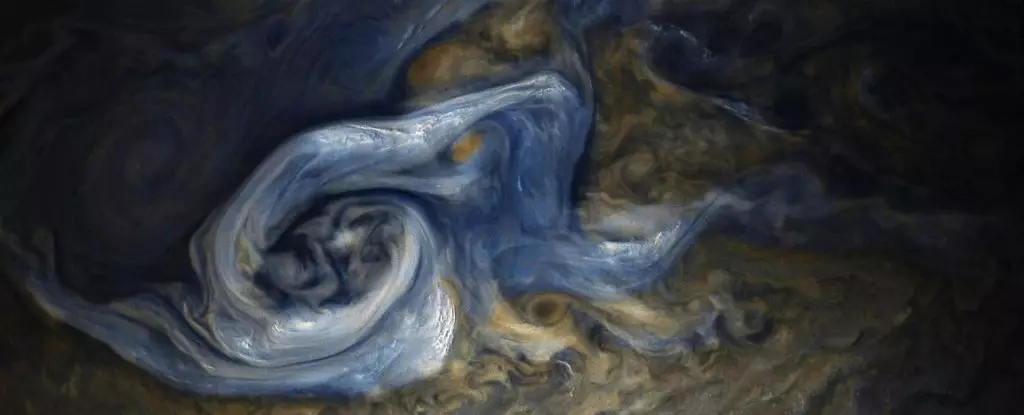While we often think of Jupiter as a majestic, swirling gas giant, its atmospheric processes can surprisingly parallel certain meteorological events we encounter on Earth.However, the sheer size of these events and their odd resulting phenomena raise eyebrows and challenge previous understandings of planetary atmospheres. At the heart of this exploration is a striking discovery: during monstrous electrical storms, Jupiter’s clouds generate bizarre “mushballs,” ice entities composed of ammonia and water that exhibit eccentric properties. Understanding how these mushballs form may open up new avenues in planetology and expand our comprehension of gas giants within and beyond our solar system.
The Genesis of the Mushball Hypothesis
The hypothesis surrounding mushballs was born from data gathered by NASA’s Juno probe, which has been diligently investigating Jupiter’s atmosphere since its arrival in 2016. Initial indications of strange weather patterns were revealed in 2020, when researchers attempted to deduce the elusive dynamics that govern the distribution of ammonia in Jupiter’s clouds. The proposed mechanism suggests that violent storms elevate water high into the atmosphere, where it meets ammonia vapor. This interaction creates a precipitation system that allows for the formation of these mushballs—a process completely foreign to Earth’s meteorology.
Scientists Chris Moeckel from UC Berkeley and his colleagues Imke de Pater and Huazhi Ge painstakingly reviewed both Juno and Hubble Space Telescope data to support their audacious theory. Moeckel, who initially harbored skepticism about their findings, spent three arduous years trying to disprove the mushball theory—only to find it robust and compelling. This reflects a powerful truth in scientific inquiry: the most remarkable revelations often challenge our preconceived notions and lead us to rethink established knowledge.
The Role of Extreme Conditions
Jupiter’s atmosphere is fraught with a mix of elements that contribute to the formation of mushballs. High-altitude storms unleash torrents of water, which subsequently combine with ammonia droplets in a unique interplay driven by extreme conditions. When the ice forms in colder regions of the atmosphere, the ammonia acts as an antifreeze, thus lowering the melting point of water and fostering a bizarre state of ammonia-water liquid.
This discovery emphasizes that the processes that take place in the upper atmosphere are not merely superficial. While these storms are relatively shallow—often extending only 10 to 20 kilometers below cloud tops—the implications of their dynamics run much deeper. Cyclonic vortices and dramatic thunderstorms not only influence the upper atmosphere but also facilitate the transport of ammonia deep into Jupiter. The formation and precipitation of mushballs deepen our understanding of how chemical elements behave in a vast gas giant, revealing a complex mixture of processes at work.
Unpacking the Implications for Planetary Science
The implications of the mushball phenomenon extend beyond the confines of Jupiter’s atmosphere. The findings represent a significant advance in understanding how gaseous planets behave, paving the way for refining models applicable to not just Jupiter but other giants in our solar system like Saturn, Uranus, and Neptune. This insight into atmospheric dynamics could eventually assist astronomers in determining the chemical compositions of exoplanets, granting a glimpse into the potentially habitable conditions that exist beyond our solar neighborhood.
As researchers continue to analyze the colossal storms and their gas exchanges, new avenues of inquiry will likely blossom. The notion that mushball storms could exist across other giant planets or even exoplanets suggests that crucial processes governing atmospheric phenomena may be strikingly similar, even across vast cosmic distances. For scientists, this is an exhilarating prospect that may reshape our understanding of planetary formation and development.
Confronting the Mystery: The Next Steps in Research
Despite being an emerging framework, the mushball theory calls for further verification through detailed examination of atmospheric data and ongoing observations. Groundbreaking insights may still lie dormant in the quiet signals emitted by these storms, waiting for researchers to interpret and decode. Future missions and enhanced telescope capabilities provide hope that we may unveil further secrets of the gas giants.
The journey into Jupiter’s swirling atmosphere underscores a core principle inherent in scientific discovery: knowledge often begins with curiosity and skepticism. For every discovery lies a story of meticulous analysis, fervent inquiry, and the challenge of reconciling apparent contradictions in the natural world. Jupiter’s enigmatic weather invites us to continue our exploration and remain steadfast in our commitment to deepening our understanding not just of our solar system, but of the vast universe that surrounds us.


Leave a Reply